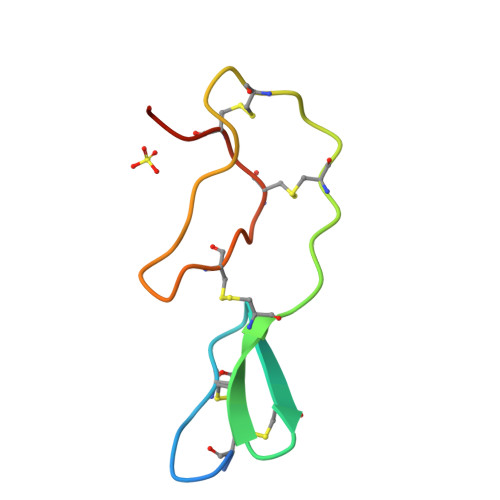The 1.2 A crystal structure of hirustasin reveals the intrinsic flexibility of a family of highly disulphide-bridged inhibitors.
Uson, I., Sheldrick, G.M., de La Fortelle, E., Bricogne, G., Di Marco, S., Priestle, J.P., Grutter, M.G., Mittl, P.R.(1999) Structure 7: 55-63
- PubMed: 10368273
- DOI: https://doi.org/10.1016/s0969-2126(99)80009-4
- Primary Citation of Related Structures:
1BX7, 1BX8 - PubMed Abstract:
Leech-derived inhibitors have a prominent role in the development of new antithrombotic drugs, because some of them are able to block the blood coagulation cascade. Hirustasin, a serine protease inhibitor from the leech Hirudo medicinalis, binds specifically to tissue kallikrein and possesses structural similarity with antistasin, a potent factor Xa inhibitor from Haementeria officinalis. Although the 2.4 A structure of the hirustasin-kallikrein complex is known, classical methods such as molecular replacement were not successful in solving the structure of free hirustasin. Ab initio real/reciprocal space iteration has been used to solve the structure of free hirustasin using either 1.4 A room temperature data or 1.2 A low temperature diffraction data. The structure was also solved independently from a single pseudo-symmetric gold derivative using maximum likelihood methods. A comparison of the free and complexed structures reveals that binding to kallikrein causes a hinge-bending motion between the two hirustasin subdomains. This movement is accompanied by the isomerisation of a cis proline to the trans conformation and a movement of the P3, P4 and P5 residues so that they can interact with the cognate protease. The inhibitors from this protein family are fairly flexible despite being highly cross-linked by disulphide bridges. This intrinsic flexibility is necessary to adopt a conformation that is recognised by the protease and to achieve an optimal fit, such observations illustrate the pitfalls of designing inhibitors based on static lock-and-key models. This work illustrates the potential of new methods of structure solution that require less or even no prior phase information.
Organizational Affiliation:
Institut für Anorganische Chemie der Universität, Tammannstrasse 4, D-37077 Göttingen, Germany.



















